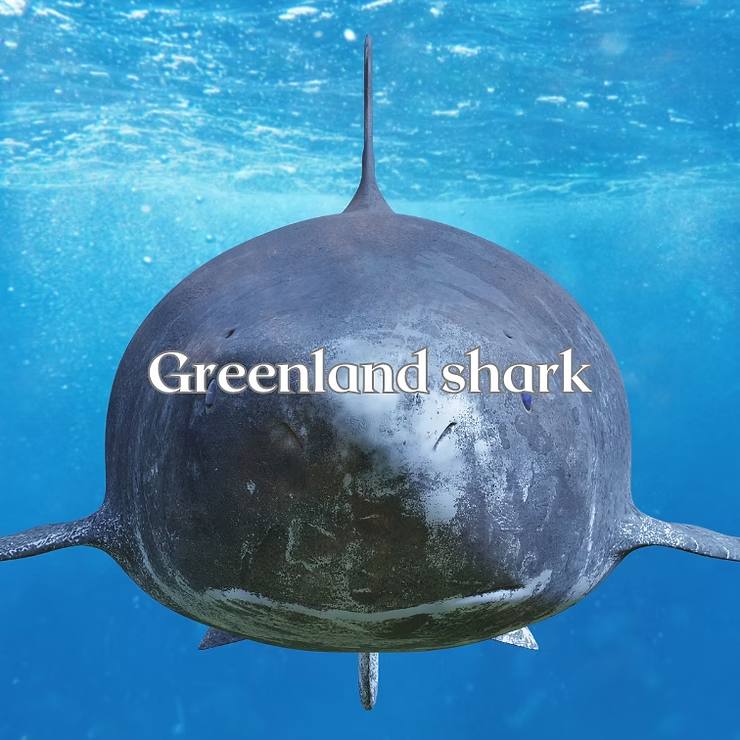Introduction
The Greenland shark is one of the most fascinating creatures of the ocean. Known for its massive size, mysterious lifestyle, and exceptional longevity, it has captivated scientists and explorers for centuries. This article explores the Greenland shark’s unique characteristics, habitat, feeding habits, reproduction, and record-breaking lifespan, uncovering what makes it one of the most remarkable vertebrates on Earth.
The Mysterious Greenland Shark
A Shark Like No Other
The Greenland shark is unlike any other shark species. Adapted to survive in the extreme cold of the Arctic, it swims with a sluggish, almost lethargic style. Despite this, it is among the largest sharks, growing up to 20 feet long or more. Its slow speed reflects both its physiology and the icy waters it inhabits, yet it thrives where few species can.
Most fascinating of all, Greenland sharks are among the longest-living animals on the planet. With lifespans exceeding 400 years, they are a living symbol of resilience and survival in one of Earth’s harshest environments.
Habitat and Distribution
Greenland sharks live primarily in the deep, cold waters of the North Atlantic and Arctic oceans, particularly near Greenland, Iceland, and Canada. Their bodies contain natural antifreeze compounds—urea and trimethylamine oxide—that allow them to endure temperatures as low as -2°C. They are bottom-dwellers, usually found at depths of 200 to 600 meters, but they can go deeper when needed.
Although mainly limited to Arctic regions, rare sightings have occurred elsewhere, including the Pacific Ocean and Mediterranean Sea, though these are exceptions rather than the norm.
Feeding Habits
The Greenland shark is an opportunistic feeder with a highly varied diet. It is primarily a scavenger but also hunts when the opportunity arises.
- Main diet: Fish, seals, and other sharks
- Unexpected finds: Polar bear remains, reindeer, and even human-made debris like car tires
- Feeding strategy: Ambush hunting near the ocean floor and powerful jaws designed for gripping and tearing
They also engage in cannibalism during food shortages, consuming smaller members of their own species.
Reproduction and Growth
Greenland sharks reproduce through viviparity, meaning females give birth to live young rather than laying eggs. The gestation period is long—estimated at 12 to 15 months. Courtship often involves males biting the female’s fins before mating. Litters may include 10 to 20 pups, though much about their reproduction remains a mystery.
They grow slowly and do not reach sexual maturity until around 150 years of age, which makes recovery from population declines particularly difficult.
Longevity and Aging
Greenland sharks are record-holders for longevity, living up to and beyond 400 years. Scientists determine their ages by analyzing the proteins in their eye lenses, which accumulate over centuries. Their slow growth rate and delayed reproduction suggest an evolutionary tradeoff: long life spans for slow population turnover.
- Greenland sharks can live over 400 years
- They take centuries to reach sexual maturity
- With age, their metabolism slows and they become less active
- Despite aging, they thrive in extreme Arctic conditions
Conclusion
The Greenland shark is truly a marvel of the ocean. From its immense size and unique Arctic adaptations to its record-breaking longevity, it stands as one of nature’s greatest mysteries. While much remains to be discovered about its reproduction and behavior, one thing is clear: the Greenland shark is a living time capsule, swimming silently through the icy depths for centuries.
Frequently Asked Questions
- How big can Greenland sharks grow? Up to 24 feet in length.
- Where do they live? In the cold waters of the Arctic and North Atlantic.
- What do they eat? Fish, seals, and scavenged remains.
- How do they reproduce? Females give birth to live pups after long pregnancies.
- How long do they live? Over 400 years, making them the longest-lived vertebrate.
- How do they hunt? They rely on ambush tactics and strong jaws for gripping prey.
- Do they migrate? Evidence suggests they may travel long distances seasonally.
- Are they dangerous to humans? No, they rarely interact with people and are not a threat.

